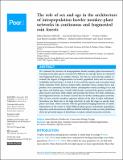Por favor, use este identificador para citar o enlazar a este item:
http://hdl.handle.net/10261/133326COMPARTIR / EXPORTAR:
 SHARE SHARE
 CORE
BASE CORE
BASE
|
|
| Visualizar otros formatos: MARC | Dublin Core | RDF | ORE | MODS | METS | DIDL | DATACITE | |

| Título: | The role of sex and age in the architecture of intrapopulation howler monkey-plant networks in continuous and fragmented rain forests |
Autor: | Benítez-Malvido, Julieta; Martínez-Falcón, Ana Paola; Dáttilo, Wesley; González-DiPierro, Ana María; Lombera Estrada, Rafael; Traveset, Anna CSIC ORCID | Palabras clave: | Sex-classes Sex class Age classes Age Nestedness Habitat fragmentation Consumer-resource interactions Alouatta pigra |
Fecha de publicación: | 14-mar-2016 | Editor: | PeerJ | Citación: | PeerJ 2016(3): 1809 (2016) | Resumen: | We evaluated the structure of intrapopulation howler monkey-plant interactions by focusing on the plant species consumed by different sex and age classes in continuous and fragmented forests in southern Mexico. For this we used network analysis to evaluate the impact of fragmentation on howler population traits and on resource availability and food choice. A total of 37 tree and liana species and seven plant items (bark, immature fruits, flowers, mature fruits, immature leaves, mature leaves and petioles) were consumed, but their relative consumption varied according to sex and age classes and habitat type. Overall, adult females consumed the greatest number of plant species and items while infants and juveniles the lowest. For both continuous and fragmented forests, we found a nested diet for howler monkey-plant networks: diets of more selective monkeys represent subsets of the diets of other individuals. Nestedness was likely due to the high selectivity of early life stages in specific food plants and items, which contrasts with the generalized foraging behaviour of adults. Information on the extent to which different plant species and primate populations depend on such interactions in different habitats will help to make accurate predictions about the potential impact of disturbances on plant-animal interaction networks. | Versión del editor: | http://dx.doi.org/10.7717/peerj.1809 | URI: | http://hdl.handle.net/10261/133326 | DOI: | 10.7717/peerj.1809 | Identificadores: | doi: 10.7717/peerj.1809 issn: 2167-8359 |
| Aparece en las colecciones: | (IMEDEA) Artículos |
Ficheros en este ítem:
| Fichero | Descripción | Tamaño | Formato | |
|---|---|---|---|---|
| benitez-PeerJ-2016-1809.pdf | 4,54 MB | Adobe PDF |  Visualizar/Abrir |
CORE Recommender
PubMed Central
Citations
1
checked on 20-mar-2024
SCOPUSTM
Citations
16
checked on 17-abr-2024
WEB OF SCIENCETM
Citations
13
checked on 29-feb-2024
Page view(s)
222
checked on 18-abr-2024
Download(s)
240
checked on 18-abr-2024

